Havana:
Everything Old is New Again
by Peter Flaherty ![]()
On a recent trip to Havana, the vibrant capital of Cuba, I was struck by how much had changed since my last visit, over a decade before. At the same time, it was fascinating to note how much we associate with the “old” Havana — dating from before Fidel Castro’s communist revolution — is not only still there to see but is also being eagerly marketed for foreign tourists.
While it remains very difficult
for Americans to visit the island, visitors from Canada and Europe are
coming in increasingly large numbers. A flood of European business travellers
is also descending on Havana to negotiate trade and commercial deals before
the widely anticipated arrival of the Americans, once the economic and
trade blockade is eventually lifted.
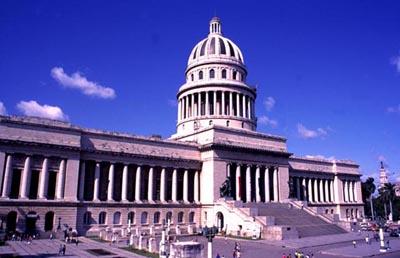
Swanky new hotels are springing up all over the fashionable western suburb of Miramar, many of them joint ventures between Cuban and European enterprises, along with attractively designed condominium towers, fancy restaurants, shopping malls, and a state-of-the art conference centre.
Such intriguing new developments are starting to make Miramar resemble the more upscale areas of Miami’s South Beach. But along with all this recent construction, other parts of the city, especially Habana vieja (old Havana) are being painstakingly and lovingly renovated, with considerable financial assistance from UNESCO, the United Nations agency dedicated to cultural development. There is in all this considerable irony that Havana’s rich history, including its Spanish colonial heritage, its place in Cuba’s tumultuous history after independence, its risqué role as a “pleasure centre” for tourists (and mafiosi) during the pre-Castro years, and of course the dramatic events of the Revolution itself, are all being promoted for their tourist appeal. In addition, old colonial buildings are being converted into appealing little boutique hotels right in the centre of town, while it is also becoming increasingly possible to find “bed and breakfast” style accommodation in casas particulares (private homes), and dine on delicious traditional Cuban dishes at family-run paladares (private restaurants).
Yes, Fidel Castro’s communist government still keeps a firm grip on power, and even the visitor can sometimes be made aware of its heavy hand. The country continues to creak along at a sometimes frustratingly inefficient pace and many Cubans are obviously impatient for even more reform, an easier life, and greater personal freedom that they hope will be theirs in the years to come. But they are also intensely proud of their country, its thriving culture, and the undeniable achievements of their revolution. As Cuba approaches the 50th anniversary of Castro’s seizure of power, important developments are propelling it into a new and so far largely uncharted future. Amidst all the uncertainty and apprehension regarding what will happen once Castro leaves the stage, one clear conclusion is emerging. A new breed of pragmatic young technocrats is already in charge of running the day-to-day affairs of the country, leaving to Fidel, the aging “lider maximo” (maximum leader) the task of delivering his traditional lengthy, nationally-televised morale-building speeches on special occasions. Even while still alive, Castro has become something of a figurehead for the revolution, while the next generation is already making careful plans for the inevitable transition that lies ahead.
The Cuban conundrum
This new generation of leaders wants to preserve what it views as the positive gains of their revolution, including universal health care and education, a social safety net that is the envy of most Latin American countries, and Cuba’s influential role in world affairs. But at the same time, they realize that much will have to change in the post-Castro era. It is obvious that they are aware of the enormous potential their island and its culture has for tourism, and they are doing their best to develop this part of the economy, which is now the main earner of foreign currency. And they are also preparing for what they view as the inevitable arrival of the Americans – leisure tourists, business travellers, and travel industry entrepreneurs. They are working hard at improving their infrastructure, modernizing their facilities, and making strategic marketing decisions to emphasize the parts of their island’s rich cultural heritage that will appeal most strongly to potential visitors. One of the most important ways of doing this is to capitalize on all the richness of Cuba’s past history, coupling it with what is an undeniably thriving contemporary musical and cultural scene, and present it to the world as fascinating mixture of old and new.
On arrival at Havana’s recently modernized Jose Marti airport, my friend and I were met by Ernesto, a representative of one of the government tourist agencies catering to foreign tourists. There are a number of such enterprises, all state-run, but encouraged to compete for a share of the tourist market. This gives their employees the incentive to provide superior service and a greater range of choices for travellers, for with increased market share come valuable bonuses, paid in hard currency. We were taken to the Hotel Occidental Miramar, which was to be our base of operations for our week in Havana. This ultramodern hotel was originally part of the Novotel chain, and was built by a Spanish company. The friendly desk staff offered us a complementary cocktail to celebrate our arrival as we checked in and admired the spacious lobby and adjacent bars. Before leaving, Ernesto suggested that we consider taking a private tour of Havana the next day, with another guide, a charming and very knowledgeable young woman named Lorelis. This proved to be an excellent idea, since the tour was not only very reasonable, but took over half a day and was a great introduction and orientation to the city. After a quick stop in our very comfortable and well-appointed room, we were ready to explore the sights and sounds of Havana by night.
The Cuban rhythm
On the flight down from Toronto, we had met a young American woman who was working abroad, and was visiting Cuba for the first time. As we were about to land, her excitement and anticipation noticeably grew, as she was aware of the fact that by travelling to Cuba she was doing something of which her government took a very dim view. The Cuban immigration authorities were very considerate, however, not stamping her passport so that there would be no record of her stay. She later told us that she had been greeted with great friendliness and courtesy. We arranged to meet her later that evening for a drink on the outdoor patio of the Hotel Inglaterra, in central Havana. One of the best ways of appreciating Havana’s legendary history is to visit the bars, restaurants, or even the lobbies of its fabled hotels. Many of them are mini-museums, with fascinating photo displays of various episodes in their history that mark major events in Cuba’s past. The Inglaterra is no exception. Built in 1875, it ranks as the city’s oldest hotel still in operation. The Café el Louvre, where we took our first mojitos in Havana, (the best I’ve ever tasted, by the way), made a great place to watch the passing crowd and consider our next stop, as night fell on the old city and the movido (nightly action) began to build.
Strolling down the narrow, dimly lit streets of Old Havana after nightfall proved somewhat disorienting and confusing at first. But once we were able to figure out the main thoroughfares and landmarks, it became easier to explore this fascinating, atmosphere-laden area of the city. By day the area is pulsing with activity, with both tourists and local residents thronging the streets and shops. After considerable searching, we were able to find a paladar that had been recommended to us, the Casa Julia. Located on the oddly named Calle O’Reilly, (actually named for a transplanted Irishman who served the Spanish Crown during the 18th century), it claims to be among the first private restaurants that the regime permitted to open in the early 1990s. This decision to allow some small-scale private enterprise formed part of the package of market reforms introduced after the collapse of communism in the Soviet bloc, once Cuba’s economic lifeline. The owners eagerly greet visitors, and are obviously proud of their small establishment and its outstanding food and service. Finding small private restaurants like the Casa Julia can present the visitor with a challenge, since among the many restrictions the regime imposes on them is the fact that they are not permitted to use large signs to advertise their location. But everyone in the neighbourhood knew about the Casa Julia, and with a little asking we had no trouble locating it.
After dining on a delicious, traditional Cuban meal of roast chicken or pork with the ubiquitous frijoles y arroz (red beans and rice, similar to the New Orleans variety), and some excellent Cuban beers, we were refreshed and eager to take in some of the city’s famous musical entertainment. One of the owners of the restaurant actually insisted on escorting us personally to his recommended choice for our first of many nights on the town in Havana – La Casa de la Musica de Centro Habana . Housed in an old building in central Havana, this recently revamped hall has a huge dance floor, surrounded by tables for drinking and and just observing the scene. Its light and sound systems are state-of-the-art, and the show was a production worthy of New York or Las Vegas in its extravagance and energy. A number of different acts performed, including dancers, acrobats, a singer, and a salsa orchestra that took the stage for the grand finale. By this time almost everyone in the crowd was up on the floor and dancing. However, since it had been a long and tiring day for us, we grabbed a private taxi back to our hotel, just when it looked as if the younger crowd in old Havana was beginning its night of serious partying.
Mixed messages
After we had partaken of a substantial breakfast buffet in one of the hotel’s many restaurants, Lorelis and her driver were waiting for us in the lobby. We proceeded from the hotel into the old part of Havana along the oceanfront Malecon. On one side the waves of the Caribbean crashed against the breakwater. On the other we admired a string of architectural gems, some in desperate need of repair, others lovingly restored to colonial perfecion. Along the way, we passed the U.S. Special Interests Section headquarters, where a skeleton crew of American diplomats handles the country’s long-strained relations with the United States.
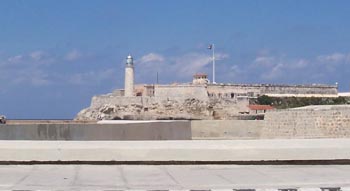
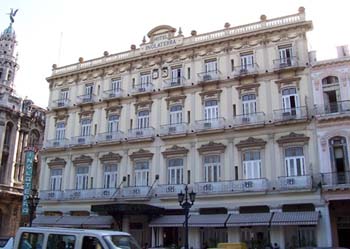
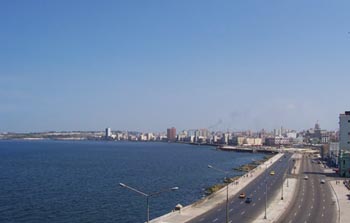
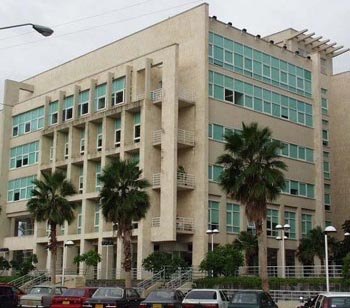
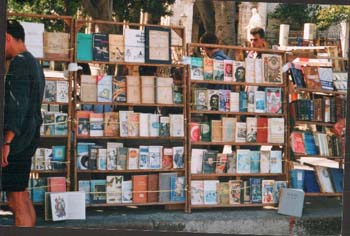
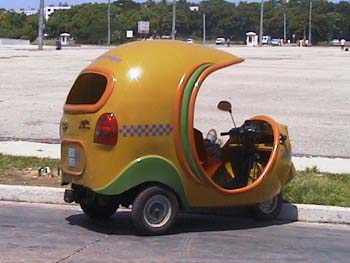
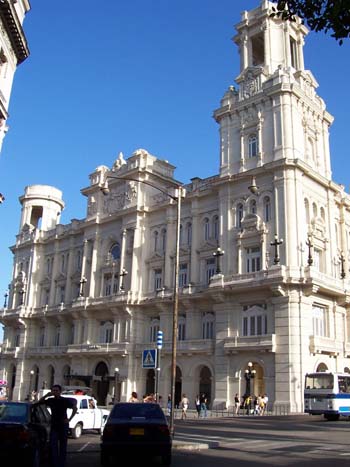
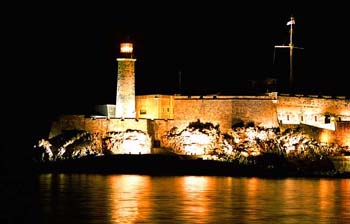
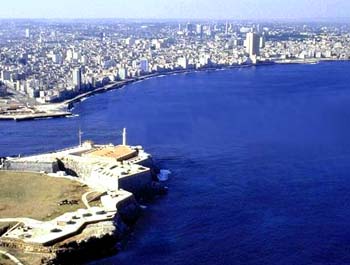
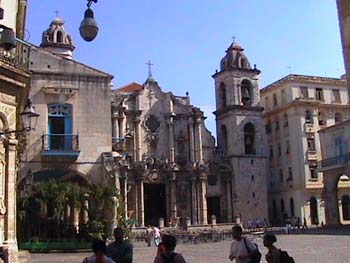
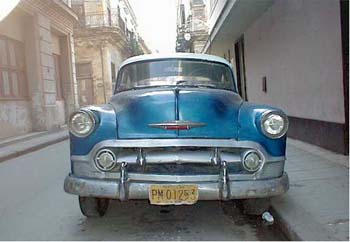
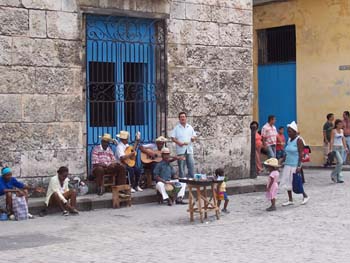
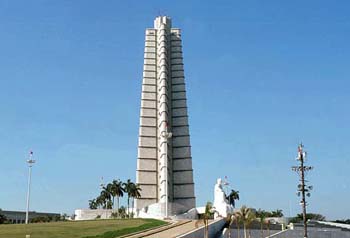
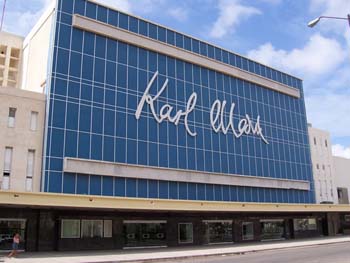
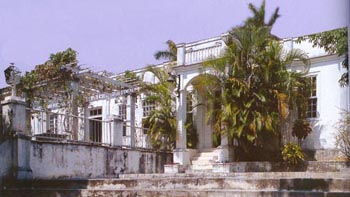
Castro has created a huge outdoor meeting-place just outside the building, which he occasionally uses to launch attacks on American foreign policy, including the war in Iraq. We noticed many billboards denouncing the Bush administration, and expressing Cuba’s determination to remain independent and free of U.S. pressure to get Cubans to change their system of government. But despite the regime’s propaganda, most Cubans appear to be genuinely friendly towards Americans, and anxiously await the day when they will visit the island once again. Many aspects of American culture, such as rap music, Hollywood movies, basketball, and especially baseball are eagerly embraced, and thousands of Cubans depend on remittances their Florida-based relatives send them as a much-needed supplement to what remains a very meager, spartan life for the average Cuban family.
Havana's colonial history
Our first stop in Malecon was El Castillo de los Tres Reyes del Morro, or the Morro Castle, one of the three main fortifications dating from the Spanish colonial era that guarded Havana’s natural harbour. Built between 1589 and 1630, it was designed to provide a cross fire for attacking ships with the Castillo de San Salvador de la Punta on the opposite side of the narrow waterway leading from the bay into the city. From its ramparts one can gain an excellent, panoramic view of the city’s skyline, and Lorelis used our location to point out some of the more famous buildings in the city. Not far away is the Fortaleza San Carlos de la Cabana (the Cabana Fort), built in the 18th century and meant to be one of the most imposing and complex defensive systems in Spain’s American colonies. A mini-city in itself, complete with cobble-stone streets lined with houses where soldiers and their families once lived, it serves today as a venue for public events. Havana’s annual Feria del Libro (Book Fair), which attracts publishers from all over the Hispanic world, was being held while we were there, and we took a taxi to la Cabana one afternoon to pay a visit. It was remarkable to see how many Cubans, of all ages, were thronging the various book exhibits. Obviously this is a well-educated society, full of people who are anxious to learn more about the world. We were left to wonder if a similar event held in our own country would attract anything like the large crowd we encountered that afternoon.
Taking an underground tunnel across the canal, we entered old Havana, where Lorelis suggested a walking tour might be the best way to see the sights of this colonial hub of the city. We started at the Plaza de Armas, a lovely open square lined with graceful palm trees. This is the oldest public place in Havana, where the Spanish conquistador Panfilo de Narvaez founded the city in 1519. The most interesting site on the square is the Palacio de los Capitanes Generales. An impressive wooden building and a priceless piece of colonial architecture, the palace served as the headquarters of the Spanish regime from its construction in the late 18th century up to the end of the Spanish-American War of 1898, when Cuba gained its independence from Spain. It now houses one of Havana’s best museums, El Museo de la Ciudad (The City Museum), which contains a number of fascinating exhibits. These include a hall of mirrors, a collection of 19th-century horse-drawn carriages, a sumptuous throne room with dark red, satin-lined walls, and the Salon Dorado (golden room), where the governor of the city received visiting dignitaries, surrounded by golden furnishings and exquisite porcelain pieces. A lovely interior courtyard contains a statue of Christopher Columbus, who “discovered” Cuba on October 27, 1492.
Old Havana
Old Havana is best experienced on foot, walking the narrow streets and admiring the architecture. After posing for the obligatory “tourist” photo with a pair of attractive young women dressed in traditional flowing white gowns and a “Carmen Miranda” style headdress made of plastic fruit, we continued towards the Plaza de la Catedral, where Havana’s main place of worship is located. This is one of the most impressive squares in Old Havana, with the massive, 18th-century baroque cathedral on one side and a number of former colonial mansions dating from the same period facing it on the other three. The cathedral was formally consecrated in 1787, over 40 years after the Jesuits had originally supervised its construction. Imposing on the outside, the interior contains dazzling gold and silver sculptures and religious paintings by Italian masters. Masses are held almost daily; since Pope John Paul II’s historic visit to Cuba in 1998, the Castro regime has permitted far more religious freedom than it once did.
Flanking the Cathedral is an outdoor restaurant called El Patio, so named because its outdoor dining area is probably the best place in Old Havana for people watching. It is possible to sip on a coffee or drink for hours while taking in the ever-changing scene passing by, including regular performances by the house band and impromptu shows by street performers. When we were there, the pre-Lenten carnival was about to begin, and we had the opportunity to witness a carnival parade, complete with costumed participants, some walking on stilts, that passed through the old streets. There are many places worth visiting in Old Havana, and the traveller could easily spend at least a day exploring them in all their rich diversity. Among these are a number of colonial churches and convents, most notably the Convento de la Iglesia de Santa Clara. This beautiful building was the city’s first nunnery, built in the mid-17th century, the interior of which has been lovingly restored with ornately carved wooden ceilings and charming, leafy cloisters. One of them houses the Centro Nacional de Conservacion, Restauracion, y Museologia, (National Centre for Conservation, Restoration, and Museology), the government agency responsible for supervising the restoration of the entire Old Havana area, an ambitious project that has been going on for over a decade now, and is still underway.
Central Havana
Just to the west of Old Havana is Central Havana, an area that rose to prominence during the last century of Spanish colonial rule and remained important into the 20th century. One of the most striking buildings here is El Capitolio, a smaller clone of Washington D.C.’s Capitol building, which once served a similar purpose, as the home of the pre-revolutionary Cuban Senate and House of Representatives. The enormous bronze female statue inside the building, symbolizing Cuba’s independence, is said to be the third largest in the world. It alone makes the visit inside worthwhile, as do the two magnificent, marble-floored chambers branching off from the ornate main entrance. Now the headquarters of the Cuban Ministry of Science, El Capitolio is primarily a tourist site, and conveys much of the magnificence and elegance of a bygone era in the country’s history.
Behind the Capitolio can be found one of Havana’s most popular sights – La Fabrica de Tobacos Partagas, the city’s main cigar factory. Originally founded in 1845, it produces the legendary Cohiba, Bolivar, and Partagas brands that are known and loved by cigar aficionados worldwide. It is possible to take a tour of the facilities, observing the various stages in the production of cigars, including drying, sorting, rolling, and boxing. Cigar rollers are considered to be among the most highly-skilled craftsmen in Cuba, turning out between 80 and 250 cigars per shift, while being read to by a “reader” who chooses a newspaper article or book to keep them occupied. Once the tour is over, visitors are conducted to the gift shop, where one can choose from an enormous variety of cigars and other tobacco products, covering a wide range of prices from the inexpensive to super-deluxe.
Another kind of history
As noted before, Havana’s inner-city hotels offer a fascinating insight into Cuba’s recent history. Many of them were built during the heyday of the country’s pre-Castro tourist boom, when countless Americans took the short flight or boat trip across the Florida Straits in search of some Latin atmosphere and excitement. In those days, almost anything was obtainable for the adventurous tourist, and the large criminal syndicates were quick to take advantage of some Americans’ desire for illicit pleasures, such as alcohol, gambling, and prostitution. Gangsters like Meyer Lansky actually made Havana their base of operations, building the Vegas-style Riviera Hotel in the swanky Vedado neighbourhood as a rival for the Las Vegas strip. Unfortunately for Lansky, his new hotel opened just before the triumph of Castro’s revolution, and one of the new government’s first acts was to suppress organized crime and deport the kingpins back to the United States. But the Riviera is well worth a visit, if only to enjoy a drink on the rooftop bar, where you can take in the spectacular view of the sweeping shoreline facing the Malecon. The Riviera, like much of Havana, appears suspended in a 1950s time warp. One would almost not be surprised to see Frank Sinatra, Sammy Davis Jr, or other members of the legendary “Rat Pack” hanging out in the hotel lobby, which they were once known to haunt during its short-lived glory days.
Two other important landmarks are the Hotel Nacional and the Hotel Sevilla, both of which figure prominently in Graham Greene’s spy thriller, Our Man in Havana, written just before the revolution. The Nacional is truly the grand-dame of Havana hostelries, opened in 1930 and declared a national monument in 1998. With a great view of the Malecon, beautiful grounds and gardens, and a stunning lobby with a photo “hall of fame” of its legendary former guests, the Nacional is well worth a visit. Its nightly floor- show, the “Cabaret Parisienne” is a great introduction to Cuban dance and folklore, with countless elaborately costumed performers energetically enacting dances from different periods of Cuba’s history. Closer to old Havana, the Sevilla is a charming Spanish-Moorish style hotel decorated with beautiful blue and white tiles, and its inner courtyard bar is a great place to unwind and listen to traditional Cuban songs performed by the house group. It has a great rooftop restaurant and pool with stunning views of the city, and its photomontage of the celebrities who have stayed there, including Al Capone. On my next visit to Havana, I plan to make the Sevilla my headquarters, since it is ideally located in the central part of town, but quiet enough to escape the crowds for a welcome respite during the day or in the evening. Staying in the outer suburb of Miramar gave me a fascinating insight into how rapidly Cuba is changing and accommodating itself to a wave of foreign tourists and businesspeople. However, the hotel, while very comfortable and ultramodern, was lacking in character and ambience, and its location far from the main sights of the city made lengthy taxi rides to and from old Havana a daily necessity.
Listening to Havana
Our week in Havana soon developed its own pleasant routine. After breakfast, we would explore some of the cultural and historic attractions of the city, usually having a light snack at one of the many bars-cum-restaurants that dot the historic district. Almost inevitably, what was initially meant to be a brief pit stop would become a more relaxed, extended stay, since most of these locations offered live music. One of our favourite spots was the Bar Vinales, on O’Reilly, where we enjoyed delicious Cuban sandwiches while listening to the house band, Amaranto y su Grupo. Anyone who has seen the film The Buena Vista Social Club, American musician Ry Cooder’s affectionate portrayal of traditional Cuban Son music from the 1930s and 40s, could be forgiven for thinking that Amaranto and the other members of his band just stepped out of it. They performed traditional Cuban standards with great skill and gusto. During one of the breaks, while marketing their CDs to the audience (every group in Havana seems to have at least one to sell), they struck up a conversation with us. In no time we found ourselves invited to attend a special performance they were organizing the following day for a local Cuban audience at one of the social clubs that can be found throughout Havana.
With a mixture of curiosity and trepidation, we made our way to the Asociacion Canarias (Canary Islands Association), a club whose members are descendents of Spaniards from the Canary Islands who settled in Cuba during the 19th century. There are many such venues around the city, offering periodic concerts and shows for members and non-members alike. When we arrived, Amaranto and his band were already in full flight, and the audience, of all ages, was energetically dancing to the Latin beat. We were the only non-Cubans in the hall, but the friendly reception we received was truly welcoming. In no time, we were being asked to dance and invited to the courtyard outside for drinks and snacks. This was truly a stroke of luck for us to be able to have the opportunity to experience an evening of genuine Cuban entertainment that was not pre-packaged for tourists. We even found we had to use regular Cuban currency, not the “tourist dollars” usually used by foreigners, at the bar.
After the show, as a gesture of our appreciation for the invitation, we invited some of the group to a restaurant in Havana’s legendary Barrio Chino (China town) for a late-night dinner. Havana’s China town is also a relic of the 1950s, complete with Chinese lanterns outside the restaurants, and many non-Chinese Cubans in traditional dress standing outside with menus, encouraging passers-by to enter. The food is also very 1950s Chinese, with chow mein, egg foo yung, and fried rice featuring prominently. But the price couldn’t be beat, and the experience again underlined how the old and the new continue to coexist in Havana. Once the home of a thriving Chinese immigrant community, the Barrio Chino is now something of a relic, since most of the city’s Chinese, active in the retail and restaurant trades, decamped for Miami and New York following the revolution in the 1960s.
Gastronomic Havana
During our stay, we tried to sample as many different restaurants as possible for our evening dinner. We had deliberately chosen not to take an “all-inclusive” tour package that would have limited us to taking our meals at the hotel. Instead, we were delighted at the variety and consistently high quality of the food and service we encountered at both private and state-owned restaurants. Among the best we experienced were Ma My, a hard-to-find paladar in Miramar, with truly excellent food and ambience. There we dined on the daily seafood special in a beautiful outdoor patio, surrounded by palm trees and flowering plants. The Ma My was not listed in any tourist guidebook, and Lorelis, tour guide, had recommended it to us. Almost impossible to find because it does not display a sign, we were finally able to track it down by asking locals for directions. It was well worth the effort. We also enjoyed a delicious meal at El Aljibe, a state-run establishment also located in Miramar, where the specialty is chicken in a peanut sauce, accompanied by huge portions of rice, beans, and plantain. The night we ate there, the place was packed, as it was Valentine’s Day, or “el dia del amor” in Cuba. This is a major holiday there, when both young dating couples and older married ones go out for a night on the town to celebrate their relationships. Many of the young men in the crowd had presented their girlfriends with roses, and everyone was dressed up for the occasion.
Following dinner, we made a real effort to take in the musical offerings at a number of Havana nightclubs, where we were always amazed at the high quality of the musicians performing. As jazz lovers, we were especially drawn to three famous establishments catering to that musical form. These were El Zorro y la Cuerva (the Fox and the Crow), in the trendy “la Rampa” district of Vedado, El Gato Tuerto (the one-eyed cat) near the Hotel Nacional, and the Jazz Café, atop the Galerias del Paseo near the Riviera Hotel. In every case, we found that for an almost laughably small cover charge, we could pass the evening enjoying top-quality music performed by remarkably skilled entertainers, while mixing with both locals and tourists in a friendly, relaxed atmosphere. The Jazz Café was packed, since we also visited it on the evening of Valentine’s Day, but we were able to find a table and enjoy some of the best drinks and music of out trip. Outside the club’s entrance, we had been met by a stunningly beautiful group of young women who were eager to invite us to spend some time with them. We politely declined the offer, but single male tourists can expect to be approached with varying degrees of persistence by “jiniteras,” or part-time prostitutes who use the money they make from this activity to supplement their meagre salaries or help their families.
Shades of the past
After the revolution, one of the Castro regime’s first acts was to ban prostitution and re-educate the women who once made their living in the sex trade in more wholesome and productive jobs. For years, the revolution could boast that it had completely cleaned up Havana, ending its period as a “sin city” catering to mainly American tourists. But with the serious economic difficulties Cuba has faced in the so-called “special period” dating from the collapse of communism in Eastern Europe, some of the old habits have re-emerged. While prostitution is not nearly as widespread as it once was, it nonetheless exists, along with a small underground drug trade. Havana is certainly not the illicit “pleasure palace” that it once was, but here is another case where at least some parts of the city’s racy past have made an appearance once again. So single male travellers, be forewarned!
Two sites of particular interest that we spent some time visiting during the day were the Museum of the Revolution and the Museo Nacional de Bellas Artes, Havana’s world-class art gallery. Both of these excellent museums are located within easy walking distance of each other, in old Havana. Anyone interested in the events leading to the triumph of Castro’s revolution, whatever their political position, cannot afford to miss the Museum of the Revolution. It is housed, no doubt ironically, in the former presidential palace of the corrupt dictator Fulgencio Batista, whose regime Castro overthrew on New Year’s Day, 1959. Displayed prominently outside are the Granma, the small ship Castro and his band of revolutionaries used to launch their invasion of the island in 1956. One can also see the tank Castro rode in as part of his personal direction of the military operations against CIA-backed anti-Castro rebels at the Bay of Pigs in 1961. An American B-26 fighter, shot down during the action, is also there to see. Inside, the heavy propaganda of the displays can sometimes wear the visitor out, but there is no denying the sheer visual appeal of the exhibits. They include old photographs of revolutionary heroes such as Camillo Cienfuegos and the Argentinian-born Ernesto “Che” Guevara, the uniforms they wore, and weapons used during the revolutionary struggle.
The Museo de Bellas Artes offers a welcome relief from the intense political messages of the Museum of the Revolution. It is a very modern building, containing an impressive collection of both Cuban and European art from colonial times to the present day. Considered to be one of Latin America’s preeminent art galleries, this museum is well worth an extended visit, since it captures the artistic creativity and vibrancy of Cuban culture. Some of the more recent works, which indicate the clear influence of abstract and expressionist schools, are truly remarkable. The gallery is pleasantly air-conditioned, and the attractive patio café makes for a relaxing stop for a drink or snack following one’s visit. There is also an excellent gift shop where one can purchase prints of some of the paintings on display.
Havana is truly a cornucopia for the visitor, offering a fascinating and delightful mixture of old and the new to savour and appreciate. Caught at times in what seems to be the 1950s, with vintage cars trolling the streets, and hotels and restaurants that do not appear to have changed at all, sometimes it feels as if time has stood still. The colonial parts of old Havana can also convey a similar impression. The cultural monuments and icons of the revolution itself, including the huge metal portrait of Che Guevara that dominates the Plaza de la Revolucion, may now seem a bit dated as the country contemplates what will surely be a much different future in the years that lie ahead. But along with these many captivating fragments from Cuba’s distant and not-so-distant past, there is something new in the air, whose implications are still not clear to either Cubans or foreign visitors. There is no doubt that the island is in the midst of a major transformation, into what one hopes wiill be a brighter, more peaceful and prosperous future for the Cuban people.
Everything old is definitely new again in Havana, and now is a truly remarkable time to experience everything this great city and wonderful, friendly inhabitants have to offer.
Recommended Web Resources